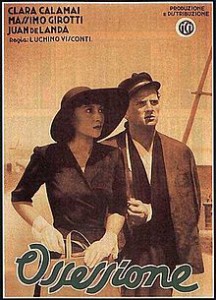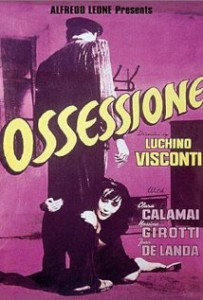Ossessione [Obsession] ***** (1943, Clara Calamai, Massimo Girotti, Dhia Cristiani, Juan de Landa) – Classic Movie Review 2,449
Debut director Luchino Visconti’s 1943 Italian crime thriller film Ossessione marks the second time James M Cain’s irresistible plot rang at cinema box offices. Visconti failed to get rights to the novel and the film was banned by the Fascist government.
Famously, The Postman Always Rings Twice, and the 1943 Italian neo-realist crime thriller film Ossessione marks the second time James M Cain’s irresistible noir thriller plot rang at cinema box offices, though the popular postman has now rung four times in the movies.
Debut director Luchino Visconti’s renowned 1943 Italian neo-realist crime thriller film Ossessione follows 1939’s Le Dernier Tournant and precedes the 1946 Lana Turner-John Garfield film The Postman Always Rings Twice and the 1981 Jack Nicholson-Jessica Lange version The Postman Always Rings Twice. It says much for Cain’s original work that all four versions are world cinema classics. Visconti’s first feature film, Ossessione is considered by many to have a claim to be the first Italian neo-realist film.
Visconti stokes up the passion, obsession and sexual heat and makes you smell the atmosphere of Italy’s Po valley as handsome vagrant drifter Gino (Massimo Girotti) awakens the lust, greed and murderous instinct of married woman Giovanna (Clara Calamai), the owner of a roadside inn he stops at. They begin a deadly affair as they plan to get rid of her older husband, Giuseppe Bragana (Juan de Landa), whom she only married for money.
As a result of the wartime production, Visconti failed to obtain rights to the novel and, because of the copyright issues, the film was not distributed outside Italy until 1976.
Working under Fascist Italian government censorship, Visconti found his initial choice of subject turned down as it involved bandits. But then he turned to a French translation of Cain’s novel given to him by French director Jean Renoir while he was working in France in the 1930s.
Adapting the book, keeping its plot for the most part, Visconti wrote the screenplay with Mario Alicata, Gianni Puccini, Antonio Pietrangeli and Giuseppe De Santis, writers from the Milanese magazine Cinema, which was edited by Benito Mussolini’s son Vittorio Mussolini. Many of the Cinema group were anti-Fascists, which the Mussolinis tolerated thinking it was necessary for the Italian film industry to innovate and compete with its rivals. Many of the Cinema group, including Visconti, later joined the resistance.
Screenings of Ossessione in Rome and northern Italy in 1943 prompted outraged reactions from Fascist and Church authorities and the film was banned by the Fascist government, which destroyed copies of the film. But Visconti managed to keep a duplicate negative, from which all existing prints have been made.
There are various versions, from
Ossessione was filmed in summer and autumn 1942. The exteriors were shot in and around the Po Valley and Ferrara, including Codigoro, Ancona, Comacchio and Boretto. Interiors were shot at Rome’s SAFA Studios.The cast are Clara Calamai as Giovanna Bragana, Massimo Girotti as Gino Costa, Juan de Landa as Giuseppe Bragana, Dhia Cristiani as Anita, Elio Marcuzzo as street performer Lo Spagnolo [The Spaniard], Vittorio Duse as Police Agent, and Michele Riccardini as Don Remigio.
Massimo Girotti died in Rome of a heart attack on 5 January 2003, aged 84, after having just completed the 2003 film Facing Windows [La finestra di fronte]. His career spanned seven decades. Ossessione was a turning point in his career.
© Derek Winnert 2015 Classic Movie Review 2,449
Check out more reviews on http://derekwinnert.com




![Ossessione [Obsession] (1943, Massimo Girotti).](http://www.derekwinnert.com/wp-content/uploads/2024/01/330px-Ossessione-1943-Girotti-300x225.png)


